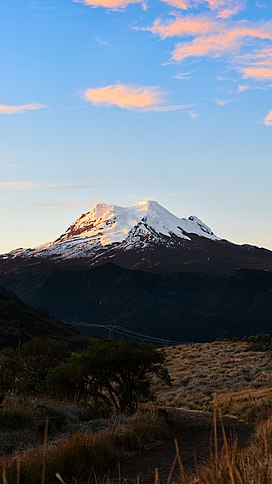| Antisana | |
|---|---|
 Northwest face of Antisana volcano at sunrise Northwest face of Antisana volcano at sunrise | |
| Highest point | |
| Elevation | 5,753 m (18,875 ft) |
| Prominence | 1,678 m (5,505 ft) |
| Listing | Ultra |
| Coordinates | 00°28′53″S 78°08′27″W / 0.48139°S 78.14083°W / -0.48139; -78.14083 |
| Geography | |
 | |
| Parent range | Cordillera Real (Andes) |
| Geology | |
| Mountain type | Stratovolcano |
| Volcanic arc/belt | North Volcanic Zone |
| Last eruption | 1801 to 1802 |
| Climbing | |
| Easiest route | snow/ice climb |
Antisana is a stratovolcano of the northern Andes, in Ecuador. It is the fourth highest volcano in Ecuador, at 5,753 metres (18,875 ft), and is located 50 kilometres (31 mi) SE of the capital city of Quito.
Antisana presents one of the most challenging technical climbs in the Ecuadorian Andes. Next to the Pichincha, Cotopaxi, Tungurahua and Chimborazo, the Antisana belongs to the five volcanic mountains that the Prussian-born explorer Alexander von Humboldt tried to climb in 1802 during his American journey.

See also
References
- ^ "Ecuador" Ultra-Prominence page. Peaklist.org. This peak is sometimes listed at 5,758 m or 5,753 m, though these figures are incompatible with SRTM data which suggests an estimated elevation closer to 5,704 m. Retrieved 2012-01-11.
- ^ "Antisana". Global Volcanism Program. Smithsonian Institution. Retrieved 2010-11-05.
- Daum, Andreas (2024). Alexander von Humboldt: A Concise Biography. Princeton, N.J.: Princeton University Press. pp. 73‒75. ISBN 978-0-691-24737-3.
External links
This Ecuador location article is a stub. You can help Misplaced Pages by expanding it. |